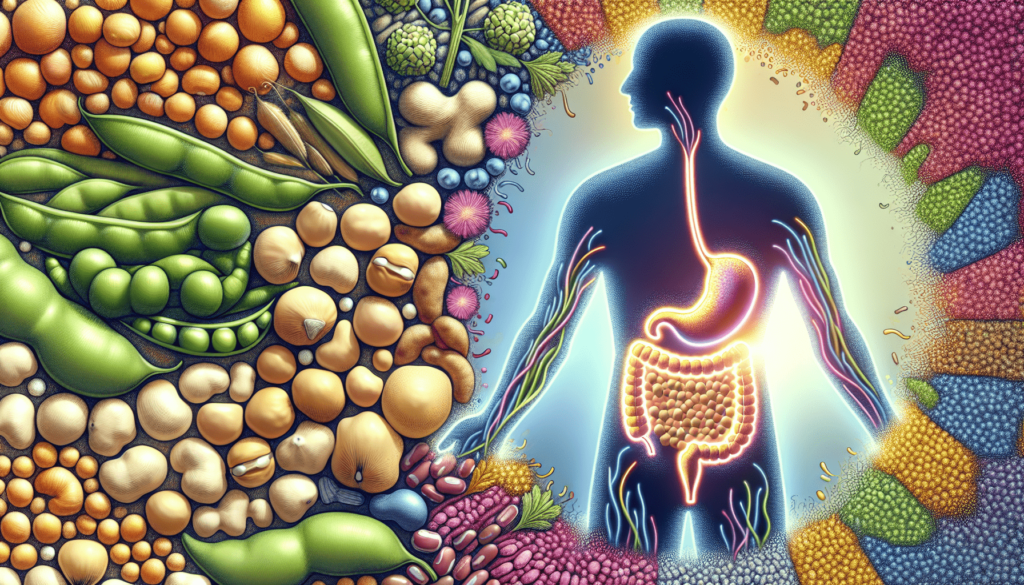Legumes have long been recognized for their nutritional value, but did you know that some legumes are particularly high in soluble fiber? Soluble fiber plays a crucial role in promoting gut health by nourishing the beneficial bacteria in our digestive system. In this article, we will explore which legumes are rich in soluble fiber and how incorporating them into your diet can have numerous benefits for your overall gut health. So, get ready to discover the legumes that can give your gut a healthy boost!
Introduction
Welcome to this comprehensive article on legumes and their importance for gut health. In this article, we will explore what legumes are, the concept of soluble fiber, the nutritional value of legumes, the benefits of soluble fiber for gut health, the connection between soluble fiber and blood sugar control, tips on incorporating legumes into a healthy diet, as well as potential side effects to be aware of. So, let’s dive in and learn how legumes can contribute to your overall well-being.
What are legumes?
Definition of legumes
Legumes are a type of plant that belongs to the Fabaceae family. They are characterized by their ability to fix nitrogen in the soil, making them an important component of sustainable agricultural practices. Legumes have been cultivated and consumed by human beings for centuries, primarily for their edible seeds. These seeds come in various shapes, sizes, and colors, and are packed with essential nutrients.
Examples of common legumes
There is a wide variety of legumes available, each with its own unique taste and nutritional profile. Some common legumes include:
- Lentils: These small, lens-shaped legumes come in a range of colors, such as green, red, brown, and black.
- Chickpeas: Also known as garbanzo beans, chickpeas are round and beige in color.
- Black beans: Black beans have a dark, black color and a creamy texture.
- Navy beans: These small, white beans are often used in soups and stews.
- Split peas: Split peas are derived from drying and splitting the seeds of certain types of peas.
- Kidney beans: Kidney beans are large, kidney-shaped beans that are commonly used in chili and other dishes.
- Pinto beans: Pinto beans are light brown in color with a speckled appearance.
- Soybeans: Soybeans are versatile legumes used to make products like tofu, soy milk, and tempeh.
- Lima beans: Lima beans are large and flat, with a buttery flavor.
- Green peas: Green peas are spherical seeds contained within a pod and are often used as a side dish or in salads.

Understanding soluble fiber
Definition of soluble fiber
Soluble fiber is a type of dietary fiber that dissolves in water to form a gel-like substance in the digestive system. Unlike insoluble fiber, which adds bulk to the stool, soluble fiber slows down digestion and is fermented by beneficial gut bacteria. This unique characteristic makes soluble fiber an essential element for a healthy gut.
Importance of soluble fiber for gut health
Soluble fiber plays a crucial role in maintaining gut health. It acts as a prebiotic, providing nourishment to the beneficial bacteria in the gut. These bacteria help in breaking down food, enhancing nutrient absorption, and promoting overall digestive health. Additionally, soluble fiber helps regulate bowel movements and prevent constipation.
Legumes high in soluble fiber
Lentils
Lentils are an excellent source of soluble fiber. They contain approximately 8 grams of fiber per cooked cup. This makes them a filling and nutritious addition to any meal. Whether you choose green, red, brown, or black lentils, you can reap the benefits of their high soluble fiber content.
Chickpeas
Chickpeas not only provide a great source of plant-based protein but also offer a significant amount of soluble fiber. With around 4 grams of soluble fiber per cooked cup, chickpeas are a versatile and healthy legume that can be used in a variety of dishes, such as hummus, salads, or curries.
Black beans
Black beans are not only delicious but also rich in soluble fiber. With approximately 2 grams of soluble fiber per half-cup serving, black beans make a fantastic addition to soups, stews, and even brownies for a nutritious boost.
Navy beans
Navy beans are another legume high in soluble fiber. They contain about 3 grams of soluble fiber per half-cup serving. These creamy, white beans are often used in baked beans, soups, and casseroles, making them a tasty and fiber-rich option.
Split peas
Split peas offer a significant amount of soluble fiber, with approximately 5 grams per cooked cup. These legumes, derived from certain types of peas, are commonly used in soups and stews. Their high soluble fiber content makes them a great choice for promoting a healthy gut.
Kidney beans
Kidney beans provide a moderate amount of soluble fiber, with around 2 grams per half-cup serving. Their versatility and nutritional value make them a popular legume choice in various cuisines, ranging from Mexican chili to Mediterranean salads.
Pinto beans
Pinto beans are another legume that contains a moderate amount of soluble fiber. With approximately 2.5 grams per half-cup serving, pinto beans can be enjoyed in dishes like burritos, refried beans, or mixed bean salads.
Soybeans
Soybeans, often used to produce soy-based products like tofu and tempeh, are an excellent source of soluble fiber. With approximately 4 grams of soluble fiber per cooked cup, soybeans offer a substantial fiber boost to any meal.
Lima beans
Lima beans, also known as butter beans, are rich in soluble fiber. With approximately 3 grams per half-cup serving, lima beans can be enjoyed in stews, casseroles, or even as a side dish.
Green peas
Green peas may be small, but they pack a punch when it comes to soluble fiber. With approximately 4 grams per cooked cup, green peas are a fantastic option for adding fiber to your diet. They can be enjoyed as a side dish, tossed in salads, or blended into a delicious pea soup.

Nutritional value of legumes
Apart from being high in soluble fiber, legumes offer a wide range of essential nutrients that contribute to overall health and well-being.
Protein content
Legumes are an excellent source of plant-based protein, making them an essential part of a vegetarian or vegan diet. They provide a substantial amount of protein, which is vital for muscle growth, repair, and various metabolic functions.
Fiber content
In addition to soluble fiber, legumes are packed with dietary fiber. This fiber aids in digestion, promotes satiety, and can assist in maintaining a healthy weight. The fiber content in legumes helps regulate blood sugar levels and cholesterol levels, reducing the risk of chronic diseases.
Mineral and vitamin content
Legumes are rich in various minerals and vitamins. They are a significant source of potassium, magnesium, and iron – essential minerals that contribute to heart health, muscle function, and oxygen-carrying capacity in the blood. Legumes also contain B-vitamins, such as folate, thiamine, and niacin, which play a vital role in energy production and cognitive function.
Benefits of soluble fiber for gut health
Promotes healthy digestion
Soluble fiber acts as a prebiotic, supporting the growth of beneficial gut bacteria. These bacteria aid in the breakdown of food and fermentation of fiber, leading to improved digestion and nutrient absorption. By promoting regular bowel movements, soluble fiber can help prevent common digestive issues like constipation.
Prevents constipation
One of the key benefits of soluble fiber is its ability to prevent and relieve constipation. Soluble fiber absorbs water in the digestive system, adding bulk to the stool and increasing its softness. This facilitates easier bowel movements, reducing the likelihood of constipation and promoting regularity.
Supports the growth of beneficial gut bacteria
The fermentation of soluble fiber by gut bacteria produces short-chain fatty acids (SCFAs), such as butyrate. SCFAs are essential for maintaining the health of the intestines and supporting the growth of beneficial gut bacteria. These bacteria play a crucial role in overall gut health and contribute to a strong immune system.
Reduces the risk of colon cancer
High-fiber diets, including those rich in soluble fiber, have been linked to a reduced risk of colon cancer. The fermentation of soluble fiber in the colon produces compounds that promote a healthy environment, potentially reducing the growth of cancer cells and minimizing the risk of developing colon cancer.
Soluble fiber and blood sugar control
Impact of soluble fiber on blood sugar levels
Soluble fiber plays a significant role in regulating blood sugar levels. When consumed, soluble fiber slows down the absorption of sugar from the digestive system into the bloodstream, preventing spikes in blood sugar levels. This slow and steady release of sugar helps maintain stable energy levels and reduces the risk of insulin resistance.
Benefits for individuals with diabetes or insulin resistance
Individuals with diabetes or insulin resistance can particularly benefit from consuming legumes high in soluble fiber. The slow digestion and absorption of soluble fiber help prevent rapid fluctuations in blood sugar levels, making it easier to manage diabetes and maintain stable blood sugar control.
How to incorporate legumes into a healthy diet
Cooking methods
Legumes can be cooked in a variety of ways to make them delicious and enjoyable. They can be boiled, sautéed, roasted, or even pressure-cooked. Experiment with different cooking methods to find the one that suits your taste preferences.
Recipe ideas
There are plenty of delicious recipes that incorporate legumes. Here are a few ideas to inspire you:
- Lentil soup: A warm and comforting bowl of lentil soup can be a nutritious meal on its own or served alongside a salad or sandwich.
- Chickpea salad: Combine cooked chickpeas with fresh vegetables, herbs, and a tangy dressing for a refreshing and filling salad.
- Black bean tacos: Fill a tortilla with black beans, salsa, avocado, and fresh vegetables for a tasty and fiber-rich lunch or dinner.
- Navy bean stew: Create a hearty stew by simmering navy beans with vegetables, herbs, and spices for a nourishing and flavorful meal.
- Split pea curry: Explore the flavors of Indian cuisine by making a fragrant split pea curry with spices, coconut milk, and vegetables.
Serving suggestions
Legumes can be served in a variety of ways to suit your taste preferences. They can be enjoyed as a side dish, added to salads, soups, stews, or used as a filling for wraps or burritos. Get creative and experiment with different flavor combinations to discover your favorite way to enjoy legumes.
Potential side effects of legumes
Gastrointestinal discomfort
Some individuals may experience gastrointestinal discomfort after consuming legumes. This can include symptoms such as gas, bloating, or stomach cramps. To help alleviate these side effects, it is recommended to start with small portions and gradually increase consumption to allow your body to adapt.
Allergic reactions
While rare, some individuals may have an allergic reaction to legumes. Allergic reactions can range from mild to severe and may include symptoms like itching, hives, difficulty breathing, or swelling of the face, lips, tongue, or throat. If you suspect an allergic reaction, seek medical attention immediately.
Conclusion
In conclusion, legumes are not only delicious but also offer numerous benefits for gut health. Their high content of soluble fiber helps promote healthy digestion, prevent constipation, support the growth of beneficial gut bacteria, and reduce the risk of colon cancer. Additionally, legumes provide a range of essential nutrients, including plant-based protein, fiber, and various minerals and vitamins. By incorporating legumes into your diet, you can enhance your overall well-being and enjoy the many advantages they offer. So, why not add some legumes to your next meal and take a step towards better gut health?

